
It’s important for the LGBTQ community to feel comfortable and welcomed in natural spaces, because finding our place in the world is such an important part of wellbeing
The LGBTQ community is most often associated with big cities, nightlife, and the arts. And while it’s true that the queer community has had a massive impact on many of the world’s great metropolises, it’s also true that humans love nature. In fact, tons of studies show that being outside and enjoying nature actually helps people’s physical and mental wellbeing.
However, it’s important for the LGBTQ community to feel comfortable and welcomed in natural spaces, because finding our place in the world is such an important part of wellbeing. Fortunately, the camping and RVing industries have really come around in recent years, focusing on increasing their diversity and providing safe and comfortable access to the outdoors for LGBTQ people.
We spoke with two leaders in the industry, Toby O’Rourke, President & CEO of Kampgrounds of America (koa.com), best known by its acronym, KOA, and Rachel Heseltine, VP of Consumer Growth at Trader International, the company that runs RV Trader (rvtrader.com). Their insight and recommendations provide a roadmap to where we are, and where we are going when it comes to LGBTQ camping and RVing.
Toby O’Rourke is passionate about sharing her love of the outdoors with others. She’s also a trailblazer and pioneer in the outdoors space, becoming one of the most high-profile names in the industry after becoming the first female CEO in KOA’s history.
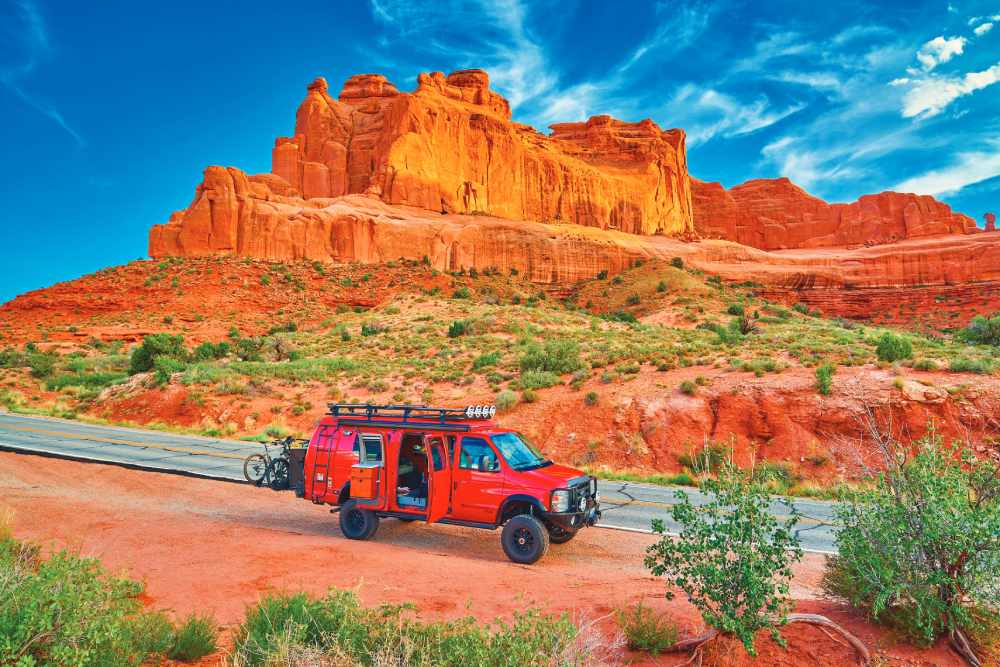
Camper Van in Arches National Park (Photo by Patrick Jennings)
Many campgrounds and RV parks tend to be outside of major urban areas, which may give many LGBTQ people the impression that they’re probably in conservative areas. Do you feel that’s true?
Our May Monthly Research Report found 6% of campers reported an incident of feeling uncomfortable due to their sexual orientation. We also ask campers to identify the camping locations where they experienced incidents, and most campers reported state parks(13%) and national parks(11%) as the primary locations, followed by privately-owned campgrounds (8%) and backcountry/wilderness areas (8%).
We understand that, for LGBTQ travelers, certain elements of outdoor recreation can still feel risky or potentially hostile. The good news is, we’ve seen more advocates, allies, and organizations out there striving to make a difference, but I believe there is still very important work ahead for outdoor companies to lead the way. We must continue to cultivate and expand diversity and inclusion in camping, outdoor recreation, and outdoor hospitality so campers from all walks of life can feel comfortable wherever they go.
With LGBTQ travelers sticking mostly to urban areas or beach resorts for travel, many simply haven’t done much camping and RVing in their lives and likely have no idea where to begin. What would you say to someone who hasn’t camped or RV’d before and might be nervous about it?
According to KOA’s research, we’re actually seeing more same-sex households choosing camping for their vacations. Notably, this year’s North American Camping Report (koa.com/north-american-camping-report) indicates the number of same-sex households has doubled since our first report in 2015, with one out of every ten camping households (12%) being a same-sex household.
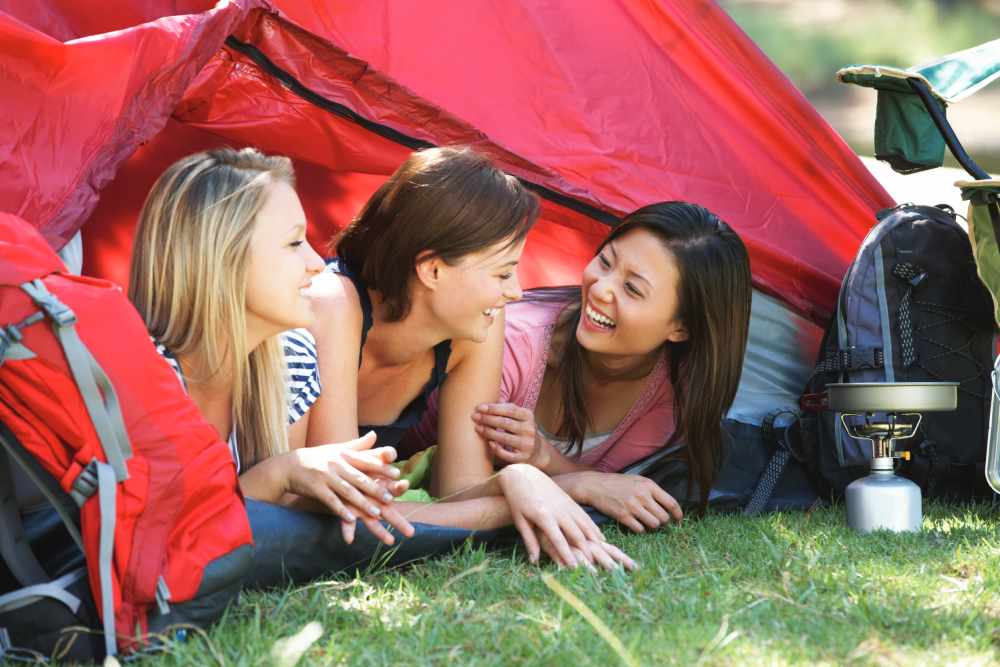
Women Camping (Photo by Monkey Business Images)
Personally, I feel that camping is the ideal getaway because you can tailor your trip to fit your needs, wants, and level of experience. For first-time campers, especially those staying in a tent or RV, it’s a good idea to start camping for a night or two as you build your confidence in the outdoors. I would also suggest visiting a campground with more amenities and services, like a KOA. It’s important to note that not all campgrounds are the same, some are nothing more than a place to pitch your tent. KOA campgrounds, on the other hand, are equipped with bathrooms, running water, a general store, and each location usually has something special that makes it feel unique, whether it’s a pond with waterslides or themed cabins.
One of my top tips is to research and familiarize yourself with your gear and campground, especially if you’re RVing. With so many different types of RVs, it’s essential to know what site you need to accommodate your rig when making reservations. For example, knowing whether your RV has slide-outs and what kind of hookups you need at your site. Generally, I recommend looking at Pull-Thru Sites if you’re new or renting an RV, as they are much simpler to navigate. If staying at a KOA, just look for the staff in yellow shirts and don’t hesitate to ask them if you have a question or need help. With the continual surge of campers venturing outdoors over the last couple of years, I also recommend booking your campsite as early as you can.
Also, as a camper myself, I feel it’s always good to say that you may encounter a few bumps along the road. But, just like any type of travel, your camping trip might not go exactly as planned, but those stories usually end up being the best!
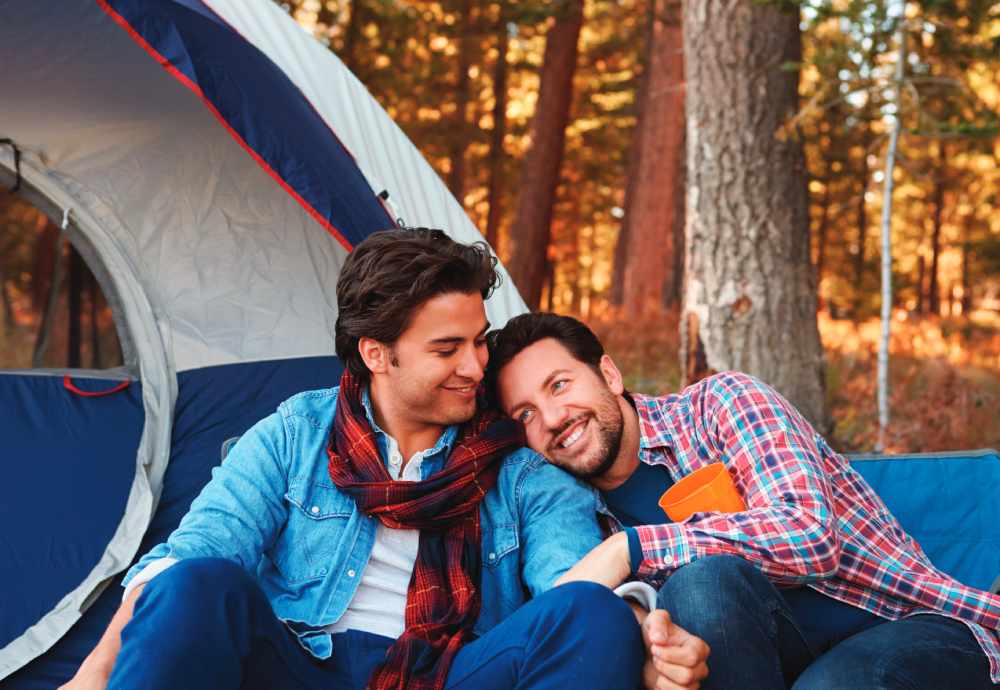
Gay Campers (Photo by Monkey Business Images)
The camping and RVing industries have really come around in recent years, focusing on increasing their diversity and providing safe and comfortable access to the outdoors for the LGBTQ people.
Studies show that nature is good for both our mental health and physical health, so it would be great to get more people to experience the world through camping and RVing. What do you think the industry can do to get more people to try it?
I believe there are intrinsic wellness benefits from being in nature. LGBTQ leisure travelers, in general, are seeking an escape from stress and want to spend time with friends and family and immerse themselves in local cultures. Camping is a perfect way to achieve that, but I know there can be a number of barriers and challenges to getting outdoors. I think the outdoors and camping industries need to continue to learn from experts and advocates working to make camping more welcoming, safe, and accessible. This includes listening to people and understanding the real-life experiences that are taking place, partnering with groups who are working to create experiences for historically underrepresented groups, and providing outdoor education where we can.
Does KOA do anything specific for the LGBTQ community, such as a Pride Day or something similar?
While COVID-19 changed how our Pride Day looks over the past few years as we maintained social distancing guidelines, we do have campgrounds that host their own Pride Day events. For example, Cape Charles/ Chesapeake Bay KOA Resort has celebrated Pride Day with a variety of organized festivities like a golf cart parade and drag brunch, and the Coleville / Walker KOA has a Pride Weekend that normally takes place in June.
Our organizational mission is to connect people to the outdoors and to each other. Our pledge to all campers, whether you’ve camped with us or not, and especially for those campers who may be from diverse groups and have not camped at all before, is that you will feel welcome and have a sense of belonging when camping with KOA. Knowing this, we have initiatives across all parts of our business to promote diversity within the outdoors and camping. This includes programs to increase representation among our campground owners and staff, specialized training, and forming a Diversity Equity and
Inclusion (DEI) Advisory Council.
Rachel Heseltine, is the VP of Consumer Growth at Trader International, the company that runs RV Trader, one of the largest RVing websites in the world that helps people buy and sell RVs. RV Trader is also known for its blog and campsite directory, both of which offer up tons of info about the best places to stay, tips for first timers, and more. As a trans person, Heseltine is determined to ensure that the outdoors is a safe space for travelers of all backgrounds.
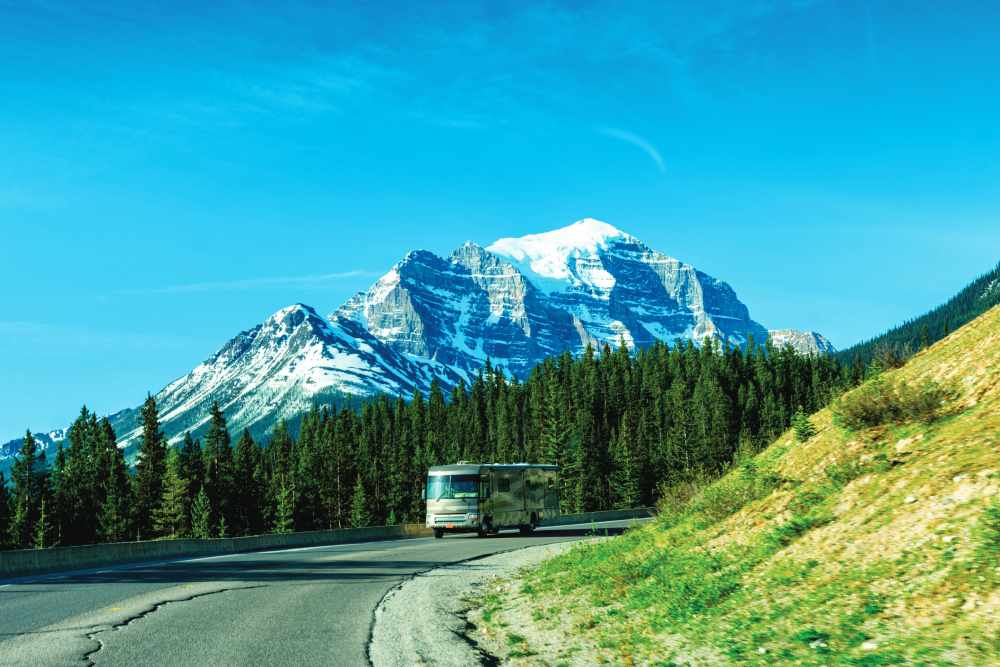
RV in Banff National Park (Photo by Yaya Ernst)
For anyone out there who has never gone RVing before, especially new RVers who are LGBTQ, what’s the best way to get started?
Well, it’s like anything else. I think the best way to get started is with research. There’s a good number of welcoming areas across the US, and there’s even some campsites and parks that specifically call themselves out as LGBTQ or LGBTQ-friendly destinations. For example, there’s The Woods (thewoodscampground.com) in the Poconos in Pennsylvania and the Rainbow Ranch (rainbowranch.net) in Texas, not too far from Austin. One trick I always use is Meetup (meetup.com).
If you’re traveling, find the local LGBTQ Meetup group in that destination and ask them for advice. If you’re looking for group travel, there’s even organizations like Out Adventures (outadventures.com). For trans and nonbinary people, there’s a great resource called REFUGE Restrooms (refugerestrooms.org). It lists nearby places that have gender-neutral or singe-person bathrooms to ensure you don’t have to be put in a difficult situation when you’re trying to use the restroom. As a trans woman, that’s always a concern when traveling to a new area that I’m not familiar with.
Unfortunately, given the current cultural climate in a lot of places, it’s now also important to check local laws. Different countries, and even states, all have different laws now…some of which are, sadly, incredibly harmful to the community. It’s important to always know where you’re heading.
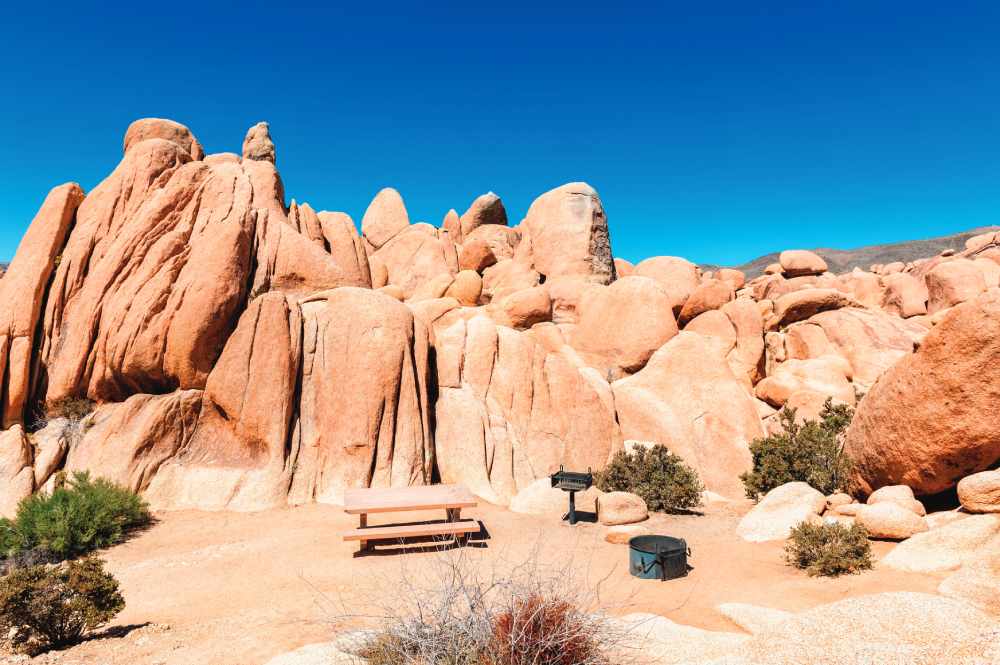
Joshua Tree National Park Campground (Photo by Allard One)
When you personally travel, what’s some of the research you do before choosing a location or destination?
I always like to make sure the lodging option is LGBTQ-friendly, even if it’s an Airbnb. I prefer knowing I’m staying in a spot that is expressively welcoming. And before heading to a destination I do the same thing I mentioned above. I investigate the destination to see what’s going on. For example, the last trip I did was to Asheville, North Carolina. It’s a small mountain town, so at first glimpse, you might not think much about it, but it’s absolutely gorgeous! It’s full of great food, and great access to hiking, rafting and swimming. There’s beautiful nature all around. Plus, even though it’s up in the mountains and not near much else, it’s an incredibly diverse and friendly town with a large LGBTQ local population.
What are some resources RV Trader offers to first-timers? Specifically, LGBTQ campers and RVers?
Our site has tons of resources. We write lots of posts that give tips for firsttime RVers, tips on what you should pack, and where to go. We even have articles for LGBTQ Rvers. In fact, one article we put up just a few months ago was ‘5 Tips for LGBTQ-Friendly RV Camping’.
Do you feel that RV Trader as a brand is inclusive and has a diverse workforce?
Yes, we actually made DEI (diversity, equity and inclusion) a huge priority back in 2020. And those measures made it much easier for me to come out to the company. I received nothing but love and great responses from everyone in the organization. I haven’t had any negative interactions since I came out here, so I have nothing but good things to say about my experience.
You might also enjoy
Out West: An Unforgettable Road Trip Through Six States
Out West: An Unforgettable Road Trip Through Six States and Several National Parks
Will Camping and RVing Be The Hottest Trend This Year
On the Road Again: Will Camping & RVing be the Hottest Trend in Travel this Year?
The post Into The Woods | LGBTQ Camping and RVing appeared first on Passport Magazine.
Into The Woods | LGBTQ Camping and RVing
It’s important for the LGBTQ community to feel comfortable and welcomed in natural spaces, because finding our place in the world is such an important part of wellbeing
The LGBTQ community is most often associated with big cities, nightlife, and the arts. And while it’s true that the queer community has had a massive impact on many of the world’s great metropolises, it’s also true that humans love nature. In fact, tons of studies show that being outside and enjoying nature actually helps people’s physical and mental wellbeing.
However, it’s important for the LGBTQ community to feel comfortable and welcomed in natural spaces, because finding our place in the world is such an important part of wellbeing. Fortunately, the camping and RVing industries have really come around in recent years, focusing on increasing their diversity and providing safe and comfortable access to the outdoors for LGBTQ people.
We spoke with two leaders in the industry, Toby O’Rourke, President & CEO of Kampgrounds of America (koa.com), best known by its acronym, KOA, and Rachel Heseltine, VP of Consumer Growth at Trader International, the company that runs RV Trader (rvtrader.com). Their insight and recommendations provide a roadmap to where we are, and where we are going when it comes to LGBTQ camping and RVing.
Toby O’Rourke is passionate about sharing her love of the outdoors with others. She’s also a trailblazer and pioneer in the outdoors space, becoming one of the most high-profile names in the industry after becoming the first female CEO in KOA’s history.

Camper Van in Arches National Park (Photo by Patrick Jennings)
Many campgrounds and RV parks tend to be outside of major urban areas, which may give many LGBTQ people the impression that they’re probably in conservative areas. Do you feel that’s true?
Our May Monthly Research Report found 6% of campers reported an incident of feeling uncomfortable due to their sexual orientation. We also ask campers to identify the camping locations where they experienced incidents, and most campers reported state parks(13%) and national parks(11%) as the primary locations, followed by privately-owned campgrounds (8%) and backcountry/wilderness areas (8%).
We understand that, for LGBTQ travelers, certain elements of outdoor recreation can still feel risky or potentially hostile. The good news is, we’ve seen more advocates, allies, and organizations out there striving to make a difference, but I believe there is still very important work ahead for outdoor companies to lead the way. We must continue to cultivate and expand diversity and inclusion in camping, outdoor recreation, and outdoor hospitality so campers from all walks of life can feel comfortable wherever they go.
With LGBTQ travelers sticking mostly to urban areas or beach resorts for travel, many simply haven’t done much camping and RVing in their lives and likely have no idea where to begin. What would you say to someone who hasn’t camped or RV’d before and might be nervous about it?
According to KOA’s research, we’re actually seeing more same-sex households choosing camping for their vacations. Notably, this year’s North American Camping Report (koa.com/north-american-camping-report) indicates the number of same-sex households has doubled since our first report in 2015, with one out of every ten camping households (12%) being a same-sex household.

Women Camping (Photo by Monkey Business Images)
Personally, I feel that camping is the ideal getaway because you can tailor your trip to fit your needs, wants, and level of experience. For first-time campers, especially those staying in a tent or RV, it’s a good idea to start camping for a night or two as you build your confidence in the outdoors. I would also suggest visiting a campground with more amenities and services, like a KOA. It’s important to note that not all campgrounds are the same, some are nothing more than a place to pitch your tent. KOA campgrounds, on the other hand, are equipped with bathrooms, running water, a general store, and each location usually has something special that makes it feel unique, whether it’s a pond with waterslides or themed cabins.
One of my top tips is to research and familiarize yourself with your gear and campground, especially if you’re RVing. With so many different types of RVs, it’s essential to know what site you need to accommodate your rig when making reservations. For example, knowing whether your RV has slide-outs and what kind of hookups you need at your site. Generally, I recommend looking at Pull-Thru Sites if you’re new or renting an RV, as they are much simpler to navigate. If staying at a KOA, just look for the staff in yellow shirts and don’t hesitate to ask them if you have a question or need help. With the continual surge of campers venturing outdoors over the last couple of years, I also recommend booking your campsite as early as you can.
Also, as a camper myself, I feel it’s always good to say that you may encounter a few bumps along the road. But, just like any type of travel, your camping trip might not go exactly as planned, but those stories usually end up being the best!

Gay Campers (Photo by Monkey Business Images)
The camping and RVing industries have really come around in recent years, focusing on increasing their diversity and providing safe and comfortable access to the outdoors for the LGBTQ people.
Studies show that nature is good for both our mental health and physical health, so it would be great to get more people to experience the world through camping and RVing. What do you think the industry can do to get more people to try it?
I believe there are intrinsic wellness benefits from being in nature. LGBTQ leisure travelers, in general, are seeking an escape from stress and want to spend time with friends and family and immerse themselves in local cultures. Camping is a perfect way to achieve that, but I know there can be a number of barriers and challenges to getting outdoors. I think the outdoors and camping industries need to continue to learn from experts and advocates working to make camping more welcoming, safe, and accessible. This includes listening to people and understanding the real-life experiences that are taking place, partnering with groups who are working to create experiences for historically underrepresented groups, and providing outdoor education where we can.
Does KOA do anything specific for the LGBTQ community, such as a Pride Day or something similar?
While COVID-19 changed how our Pride Day looks over the past few years as we maintained social distancing guidelines, we do have campgrounds that host their own Pride Day events. For example, Cape Charles/ Chesapeake Bay KOA Resort has celebrated Pride Day with a variety of organized festivities like a golf cart parade and drag brunch, and the Coleville / Walker KOA has a Pride Weekend that normally takes place in June.
Our organizational mission is to connect people to the outdoors and to each other. Our pledge to all campers, whether you’ve camped with us or not, and especially for those campers who may be from diverse groups and have not camped at all before, is that you will feel welcome and have a sense of belonging when camping with KOA. Knowing this, we have initiatives across all parts of our business to promote diversity within the outdoors and camping. This includes programs to increase representation among our campground owners and staff, specialized training, and forming a Diversity Equity and
Inclusion (DEI) Advisory Council.
Rachel Heseltine, is the VP of Consumer Growth at Trader International, the company that runs RV Trader, one of the largest RVing websites in the world that helps people buy and sell RVs. RV Trader is also known for its blog and campsite directory, both of which offer up tons of info about the best places to stay, tips for first timers, and more. As a trans person, Heseltine is determined to ensure that the outdoors is a safe space for travelers of all backgrounds.

RV in Banff National Park (Photo by Yaya Ernst)
For anyone out there who has never gone RVing before, especially new RVers who are LGBTQ, what’s the best way to get started?
Well, it’s like anything else. I think the best way to get started is with research. There’s a good number of welcoming areas across the US, and there’s even some campsites and parks that specifically call themselves out as LGBTQ or LGBTQ-friendly destinations. For example, there’s The Woods (thewoodscampground.com) in the Poconos in Pennsylvania and the Rainbow Ranch (rainbowranch.net) in Texas, not too far from Austin. One trick I always use is Meetup (meetup.com).
If you’re traveling, find the local LGBTQ Meetup group in that destination and ask them for advice. If you’re looking for group travel, there’s even organizations like Out Adventures (outadventures.com). For trans and nonbinary people, there’s a great resource called REFUGE Restrooms (refugerestrooms.org). It lists nearby places that have gender-neutral or singe-person bathrooms to ensure you don’t have to be put in a difficult situation when you’re trying to use the restroom. As a trans woman, that’s always a concern when traveling to a new area that I’m not familiar with.
Unfortunately, given the current cultural climate in a lot of places, it’s now also important to check local laws. Different countries, and even states, all have different laws now…some of which are, sadly, incredibly harmful to the community. It’s important to always know where you’re heading.

Joshua Tree National Park Campground (Photo by Allard One)
When you personally travel, what’s some of the research you do before choosing a location or destination?
I always like to make sure the lodging option is LGBTQ-friendly, even if it’s an Airbnb. I prefer knowing I’m staying in a spot that is expressively welcoming. And before heading to a destination I do the same thing I mentioned above. I investigate the destination to see what’s going on. For example, the last trip I did was to Asheville, North Carolina. It’s a small mountain town, so at first glimpse, you might not think much about it, but it’s absolutely gorgeous! It’s full of great food, and great access to hiking, rafting and swimming. There’s beautiful nature all around. Plus, even though it’s up in the mountains and not near much else, it’s an incredibly diverse and friendly town with a large LGBTQ local population.
What are some resources RV Trader offers to first-timers? Specifically, LGBTQ campers and RVers?
Our site has tons of resources. We write lots of posts that give tips for firsttime RVers, tips on what you should pack, and where to go. We even have articles for LGBTQ Rvers. In fact, one article we put up just a few months ago was ‘5 Tips for LGBTQ-Friendly RV Camping’.
Do you feel that RV Trader as a brand is inclusive and has a diverse workforce?
Yes, we actually made DEI (diversity, equity and inclusion) a huge priority back in 2020. And those measures made it much easier for me to come out to the company. I received nothing but love and great responses from everyone in the organization. I haven’t had any negative interactions since I came out here, so I have nothing but good things to say about my experience.
You might also enjoy
Out West: An Unforgettable Road Trip Through Six States
Out West: An Unforgettable Road Trip Through Six States and Several National Parks
Will Camping and RVing Be The Hottest Trend This Year
On the Road Again: Will Camping & RVing be the Hottest Trend in Travel this Year?
The post Into The Woods | LGBTQ Camping and RVing appeared first on Passport Magazine.


Post a Comment